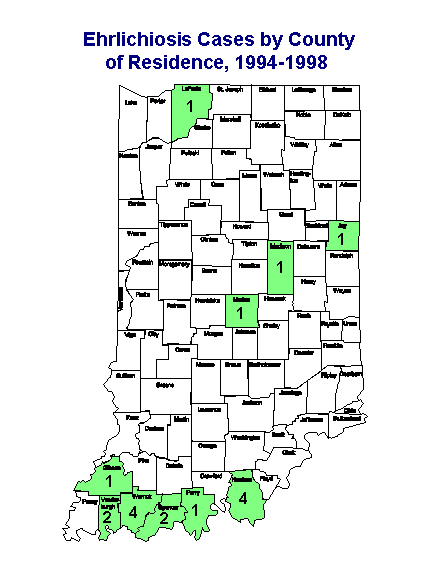
Ehrlichiosis
Cases
= 1The only confirmed case of human monocytic ehrlichiosis (HME) reported in Indiana in 1998 was in Perry County. There have been 18 HME cases reported in the past 5 years. County of residence of these cases in presented in Figure 1.
Ehrlichiosis is an acute febrile illness whose spectrum of illness ranges from extremely mild so as not to require medical treatment to life-threatening or death. Most commonly reported symptoms include: fever, headache, anorexia, nausea, myalgia, and vomiting. Thrombocytopenia and abnormal liver function test results, particularly increased hepatic transaminase levels, have also been noted. The disease resembles Rocky Mountain Spotted Fever without the rash. Diagnosis requires laboratory confirmation by indirect fluorescent antibody testing. Effective treatments include tetracycline or, for pregnant women and children under 8 years of age, chloramphenicol.
Ehrlichiosis was first recognized in the United States in 1986. The causative agent of human monocytic ehrlichiosis (HME) is Ehrlichia chaffeensis, which is closely related to E. canis, the causative agent of canine ehrlichiosis. Epidemiologic data indicates that most cases of HME are found in the south central or southeastern United States. Amblyomma americanum, the lone star tick, is a suspected vector.
An unspecified Ehrlichia causes human granulocytic ehrlichiosis (HGE). This organism is closely related to both E. phagocytophila and E. equi. Ixodes scapularis, the deer tick, is the most important vector. HGE has so far been limited to the upper Midwest and East Coast states. No human infections have been identified in Indiana to date.
Figure 1.

[an error occurred while processing this directive]